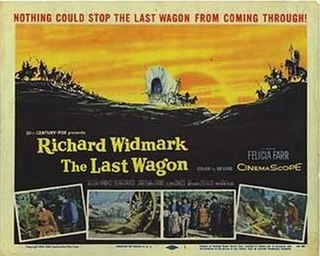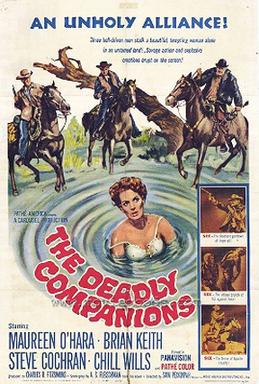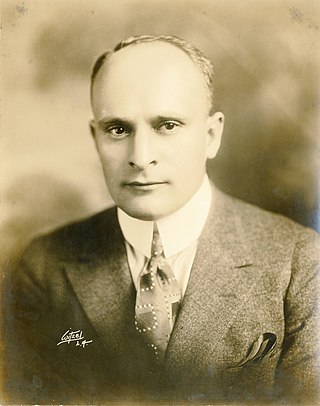
William Surrey Hart was an American silent film actor, screenwriter, director and producer. He is remembered as a foremost Western star of the silent era who "imbued all of his characters with honor and integrity." During the late 1910s and early 1920s, he was one of the most consistently popular movie stars, frequently ranking high among male actors in popularity contests held by movie fan magazines.

Young Guns II is a 1990 American Western action film and a sequel to Young Guns (1988). It stars Emilio Estevez, Kiefer Sutherland, Lou Diamond Phillips, and Christian Slater, and features William Petersen as Pat Garrett. It was written by John Fusco and directed by Geoff Murphy.

Tarzan the Magnificent is a 1960 British Eastmancolor film, the follow-up to Tarzan's Greatest Adventure (1959) and the twenty-third film of the Tarzan film series that began with 1932's Tarzan the Ape Man. Its plot bears no relation to that of the 1939 Edgar Rice Burroughs novel of the same name. The film was directed by Robert Day and produced by Sy Weintraub and Harvey Hayutin. Gordon Scott made his last appearance as Tarzan in the film, while Jock Mahoney appeared as villain Coy Banton. Mahoney would take over the Tarzan role himself beginning in the next film, Tarzan Goes to India, in 1962. The motion picture does not include Jane.

John Hartford Hoxie was an American rodeo performer and motion-picture actor whose career was most prominent in the silent film era of the 1910s through the 1930s. Hoxie is best recalled for his roles in Westerns and rarely strayed from the genre.

The Last Wagon is a 1956 American CinemaScope western film starring Richard Widmark. It was co-written and directed by Delmer Daves and tells a story set during the American Indian Wars: the survivors of an Indian massacre must rely on a man wanted for several murders to lead them out of danger.

Jane Novak was an American actress of the silent film era.

The Deadly Companions is a 1961 American Western and war film directed by Sam Peckinpah and starring Maureen O'Hara, Brian Keith, Steve Cochran, and Chill Wills. Based on the novel of the same name by A. S. Fleischman, the film is about an ex-army soldier who accidentally kills a woman's son, and tries to make up for it by escorting the funeral procession through dangerous Indian territory. The Deadly Companions was Sam Peckinpah's motion picture directorial debut.

The Covered Wagon is a 1923 American silent epic Western film released by Paramount Pictures. The film was directed by James Cruze based on a 1922 novel of the same name by Emerson Hough about a group of pioneers traveling through the old West from Kansas to Oregon. J. Warren Kerrigan starred as Will Banion and Lois Wilson as Molly Wingate. On their quest they experience desert heat, mountain snow, hunger, and Indian attack.

Invisible Stripes is a 1939 Warner Bros. crime film starring George Raft as a gangster unable to go straight after returning home from prison. The movie was directed by Lloyd Bacon and also features William Holden, Jane Bryan and Humphrey Bogart. The screenplay by Warren Duff was based on the novel of the same title by Warden Lewis E. Lawes, a fervent crusader for prison reform, as adapted by Jonathan Finn.

Two Flags West is a 1950 Western drama set during the American Civil War, directed by Robert Wise and starring Joseph Cotten, Jeff Chandler, Linda Darnell, and Cornel Wilde. The opening credits contain the following statement:
On December 8th, 1863, President Abraham Lincoln issued a Special Proclamation, whereby Confederate Prisoners of War might gain their freedom, provided they would join the Union Army to defend the frontier West against the Indians.

Allegheny Uprising is a 1939 American Adventure Western film directed by William A. Seiter and starring Claire Trevor and John Wayne. Based on the 1937 novel The First Rebel by Neil H. Swanson, with a screenplay by the film's producer, P. J. Wolfson, the film is loosely based on the historical event known as the Black Boys Rebellion, which took place in 1765 after the conclusion of the French and Indian War. It was produced by RKO Pictures.

Franklin Bryant Washburn III was an American actor who appeared in more than 370 films between 1911 and 1947. Washburn's parents were Franklin Bryant Washburn II and Metha Catherine Johnson Washburn. He attended Lake View High School in Chicago.
The Great Adventures of Wild Bill Hickok (1938) is a Columbia Pictures movie serial. It was the fourth of the 57 serials released by Columbia and the studio's first Western serial. The serial was the first to be produced by Columbia personnel; Columbia's previous three serials had been produced by the independent Weiss Brothers company, using Columbia's facilities.

The Outcasts of Poker Flat is a 1919 American silent Western film directed by John Ford and featuring Harry Carey. The film is considered to be lost. The screenplay is based upon the 1869 story of the same name by Bret Harte. Harte's story has been brought to film at least five times, including in 1937 with Preston Foster and in 1952 with Dale Robertson.

Charles Gardner Sullivan was an American screenwriter and film producer. He was a prolific writer with more than 350 films among his credits. In 1924, the magazine Story World selected him on a list of the ten individuals who had contributed the most to the advancement of the motion picture industry from its inception forward. Four of Sullivan's films, The Italian (1915), Civilization (1916), Hell's Hinges (1916), and All Quiet on the Western Front (1930), have been listed in the National Film Registry.

The Last Drop of Water is a 1911 American short silent Western film directed by D. W. Griffith and starring Blanche Sweet. Three known prints of the film survive. It was filmed in the San Fernando desert as well as Lookout Mountain, California. The film was considered the "most ambitious film made by Griffith during the California trip of 1911" before the Biograph company moved back to New York. It was filmed on or between the 14 May and May 20, 1911. It was reissued by Biograph August 13, 1915.

The Aryan is a 1916 American silent Western film starring William S. Hart, Gertrude Claire, Charles K. French, Louise Glaum, and Bessie Love.
Across the Plains is a 1911 American silent Western film directed by Broncho Billy Anderson and Thomas H. Ince and starring Anderson.

John Merton was an American film actor. He appeared in more than 250 films between 1927 and 1959, mostly as a villain. He was the brother of filmmakers André de la Varre and William LaVarre, the father of actor Lane Bradford, the grandfather of actress Diane Delano, and the great-uncle of academic Hollis Robbins.

Ambush is a 1939 American drama film directed by Kurt Neumann and written by Laura Perelman and S. J. Perelman. The film stars Gladys Swarthout, Lloyd Nolan, William "Bill" Henry, William Frawley, Ernest Truex and Broderick Crawford. The film was released on January 20, 1939, by Paramount Pictures.



















